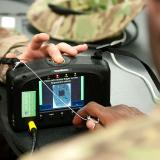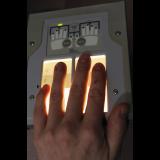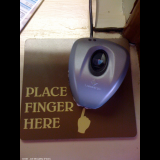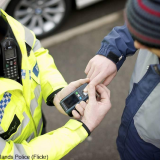
Image Gallery
To confirm the identity of a suspect, officers in the past would ask a suspect to go with them to a nearby police station; there, they would check his or her fingerprints on large stationary machines. New mobile fingerprint scanners now allow officers to check a person’s fingerprints against the local print database in seconds.
CIVIL LIBERTIES CONCERNS
Criminal databases are often rife with error. A false match could lead to a serious disruption in the life of an innocent person. Moreover, we need strict rules to make sure police do not use this technology to collect fingerprints from people not suspected of wrongdoing.
Nearly all police departments now have access to a local or state automated fingerprint identification system (AFIS), an electronic database of criminal suspect fingerprints collected over many years. King County’s AFIS, for instance, contains over 700,000 sets of prints.
- A mobile fingerprint scanner consists of a print sensor pad and an attached wireless device. The whole unit is about the size of a smart phone. The print sensor pad takes a digital image of your individual fingerprint and sends it via the wireless device to a database for comparison. Many of these devices even connect to an officer’s personal cellphone.
- Police computers compare the digital fingerprint against the hundreds of thousands of print images already stored in the database. Specialized computer programs analyze “minutia points” (distinctive grooves and ridges) and seek a match based on this data. The system typically returns a hit in as little as 30 seconds. It then transmits the linked personal profile directly back to the officer’s unit.
- AFIS databases store sensitive data, often contain many errors, and include people with no criminal past. AFIS databases link fingerprints with names, addresses, birth dates, criminal histories, and other sensitive information. Some even contain other biometric information: King County’s AFIS will soon link fingerprint and facial recognition data. Additionally, they often contain non-criminal files. For example, the FBI’s national Integrated AFIS is the largest in the world with over 70 million sets of prints and linked personal information. It includes not just criminal fingerprints, but fingerprints submitted for employment background checks, immigrant visas, and lawful firearm purchases.
Hundreds of police departments have obtained inexpensive and easy to use mobile fingerprint scanners over the past several years. Both the Department of Justice and the Department of Homeland Security generously support the purchase of mobile fingerprint scanners. In Georgia, a $1.2 million federal grant enabled 57 agencies throughout the state to acquire them.
Examples of Use
When government agencies consider acquiring and using surveillance systems, communities and their elected officials must both weigh the benefits against the costs to civil liberties and carefully craft policies and procedures that help to limit the negative effects that surveillance will have on fundamental rights. For a useful list of considerations, please visit the recommendations page.















